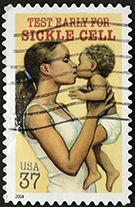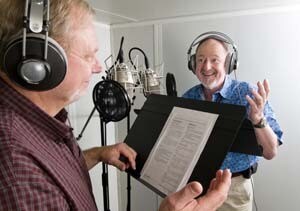Recent Episodes

Imagine a water balloon traveling down a narrow pipe when suddenly a pole inside begins expanding, stretching the balloon and slowing it down. This describes red blood cells in people with sickle cell disease. Their red blood cells are sickle shaped rather than the normal, donut shaped disks. The misshapen cells are rigid, don't flow easily through blood vessels, stick together, and block blood flow causing pain, anemia and organ damage.
Millions of people around the world suffer from sickle cell disease with few treatment options. But a recent discovery could ease the severity of this disorder.
After studying seven thousand mice engineered with sickle cell disorder, researchers keyed in on a molecule called S1P which was elevated. The molecule is generated by an enzyme called SphK1. The researchers tried inhibiting the enzyme to see if it would lower S1P levels. Not only were fewer S1P produced, the mice's symptoms were improved. Their red blood cells had less sickling and lived longer.
Healthy red blood cells live 120 days compared to sickled cells which live just ten to twenty days. That means the bone marrow can't keep up production which leads to anemia. These mice also had less tissue damage and inflammation.
The researchers found the same results when they worked with samples of human sickle cells. S1P has other roles in the body, so we'd have to see if inhibitors to SphK1 can safely and effectively be used in humans.
Up to this point, the only cure for sickle cell disease is a bone marrow transplant which is only available for a small number of people. Studies like these are needed to ease the burdens of sickle cell disease which is a lifelong illness.
More Information
Biochemists Reduce Sickling, Progression of Sickle Cell Disease in Mice
"New preclinical research on the molecular mechanisms responsible for sickle cell disease could aid efforts to develop much needed treatments for this devastating blood disorder that affects millions worldwide."
Elevated sphingosine-1-phosphate promotes sickling and sickle cell disease progression
Scientific paper on the original UTHSC sickle cell study by Yujin Zhang, et al., published in The Journal of Clinical Investigation
Sickle cell anemia
Everything you need to know about sickle cell anemia from the esteemed Mayo Clinic

Medicine...
Medicine is constantly advancing – that is a great thing about life in the 21st century. But it doesn’t just happen. Dedicated biomedical scientists are making discoveries that translate into those new medical advances.
Biomedical science is broad, encompassing everything from social science to microbiology, biochemistry, epidemiology, to structural biology and bioinformatics to name just a few areas. And, it can involve basic fundamental biology, the use of AI and chemistry to clinical studies that evaluate new medicines in patients.
No matter the research focus, the goal is always the same, to advance human health. It may take a few months, a few years or for fundamental science, a few decades. Few people make the connection that biomedical science is medicine and that biomedical scientists are working today on the medicine of tomorrow. Our weekly 500-word newspaper columns and 2-minute radio shows and podcasts provide insights into a broad range of biomedical science topics.
Medical Discovery News is dedicated to explaining discoveries in biomedical research and their promise for the future of medicine.





